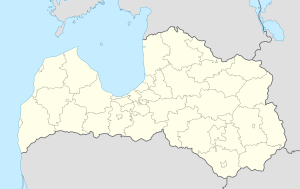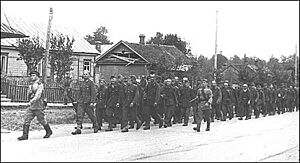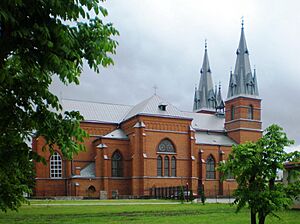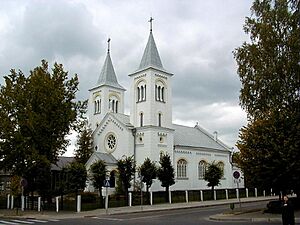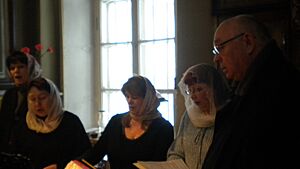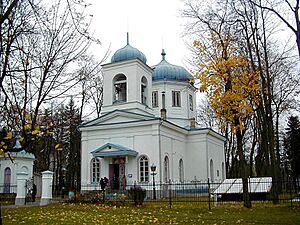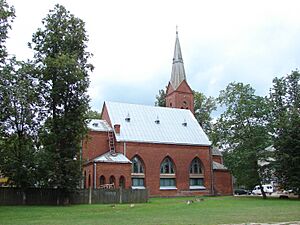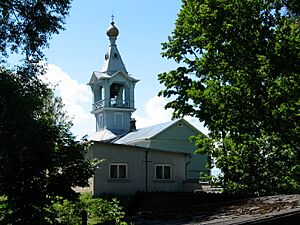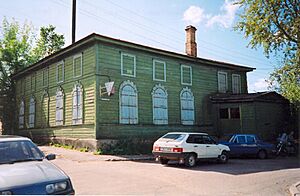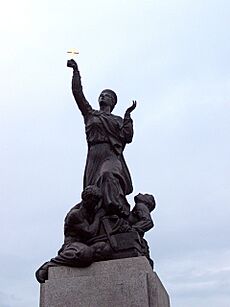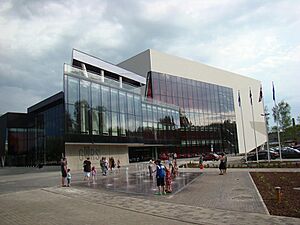Rēzekne facts for kids
Quick facts for kids
Rēzekne
|
|||||
|---|---|---|---|---|---|
|
State city
|
|||||
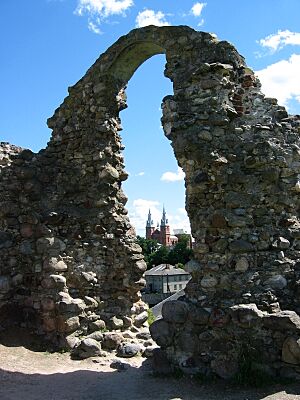
The Rēzekne castle mound with Livonian Order castle ruins
|
|||||
|
|||||
| Country | |||||
| First mentioned | 1285 | ||||
| Town rights | 1773 | ||||
| Area | |||||
| • Total | Lua error in Module:Wd at line 1,575: attempt to index field 'wikibase' (a nil value). km2 (Formatting error: invalid input when rounding sq mi) | ||||
| • Land | Lua error in Module:Wd at line 1,575: attempt to index field 'wikibase' (a nil value). km2 (Formatting error: invalid input when rounding sq mi) | ||||
| • Water | Expression error: Unexpected < operator. km2 (Formatting error: invalid input when rounding sq mi) | ||||
| Elevation | 158.2 m (519.0 ft) | ||||
| Population
(2024)
|
|||||
| • Total | 26,131 | ||||
| GDP | |||||
| • State city | 360,693,000 Euro (2021) | ||||
| • Per capita | 13,540 Euro (2021) | ||||
| Time zone | UTC+2 (EET) | ||||
| • Summer (DST) | UTC+3 (EEST) | ||||
| Postal codes |
LV-4601
LV-4604 LV-4605 LV-4606 |
||||
| Calling code | +371 646 | ||||
| Number of city council members | 13 | ||||
Rēzekne is a city in eastern Latvia, located in the Rēzekne River valley. It's often called The Heart of Latgale, which is a region in Latvia. The city is built on seven hills. Rēzekne is about 242 kilometres (150 miles) east of Riga, Latvia's capital. It's also near the border with Russia. Rēzekne is an important meeting point for railways that connect big cities like Moscow, Ventspils, and Warsaw. It is the 7th largest city in Latvia.
Contents
About Rēzekne
Other Names for the City
Rēzekne has been known by different names throughout history. In the local Latgalian dialect, it's called Rēzne or Rēzekne. In German records, it was known as Rositten. The Polish name for the city is Rzeżyca. During the time of the Russian Empire, it was called Rezhitsa.
A Look at Rēzekne's History
A long time ago, from the 9th to the 13th centuries, there was a Latgalian hill fort here. It was destroyed by German crusaders. In 1285, knights from the Livonian Order built a stone fortress on the same spot. These ruins are known today as Rēzekne castle ruins. It was an important border post.
The name Rēzekne was first written down in 1285. Over the years, many armies from Russia and Lithuania attacked the town. In 1582, Rēzekne became part of the Polish–Lithuanian Commonwealth. It gained special city rights from Poland in the 1600s. Later, it became part of the Russian Empire. In 1773, Rēzekne officially became a city.
During the 1800s, new railways were built connecting Moscow to Ventspils and Saint Petersburg to Warsaw. This made Rēzekne an important city with two train stations.
In 1917, a big meeting for the Latgale region was held in Rēzekne. People decided that Latgale should join with other Latvian regions. After Latvia became independent in 1918, Rēzekne became a key cultural center for the Latgale region.
Rēzekne was badly damaged during World War II by both the German and Soviet armies. It was captured by German troops in July 1941. Later, Soviet forces recaptured it in July 1944. Heavy bombing by Soviet planes in 1944 destroyed two-thirds of the city's buildings. Before the war, about 13,300 people lived there, but only 5,000 remained when the war ended.
After the war, Rēzekne was rebuilt. The focus was on building factories and industries. Rēzekne became one of the top industrial cities in the Latvian Soviet Socialist Republic. It had a dairy factory, a lumber mill, and an electric-instrument factory.
Population Changes in Rēzekne
The number of people living in Rēzekne has changed a lot over time. In 1897, there were 10,795 residents. This number went down to 9,997 in 1920, but then grew to 13,139 by 1935.
| Residents of Rēzekne by ethnicity (2022) | ||||
|---|---|---|---|---|
| Latvians | 47.5% | |||
| Russians | 41.6% | |||
| Poles | 2.1% | |||
| Belarusians | 1.5% | |||
| Ukrainians | 1.4% | |||
| Others | 5.8% | |||
In the 1800s, many Jewish people lived in Rēzekne, making up about 60% of the population. Russians were the next largest group. As the city grew with the railways, the population reached 23,000 before World War I.
After Latvia became independent in 1918, more ethnic Latvians moved to the city. However, Jewish people still made up about a quarter of the population in 1935. During World War II, most of the Jewish population tragically lost their lives due to the Holocaust. Many other residents were sent away to labor camps in Siberia or fled to the west. Because of this, only 5,000 people lived in Rēzekne after the war.
After the Soviet occupation of Latvia, many Russians and Belarusians moved to the city. By 1989, Russians were the largest group. After Latvia regained independence in 1991, some people moved back to Russia.
In 1991, Rēzekne had 43,156 people. Since then, the population has decreased. This is due to fewer births, an older population, and people moving to other countries or larger cities like Riga.
Places of Worship
Rēzekne has been home to many different groups of people over the centuries. Because of this, there are many different religious communities in the city. For example, Germans brought Christianity and later Lutheranism. Polish influence brought Catholicism to the local Latgalians. Russian Old Believers brought Russian Orthodoxy. Before the 1940s, there was also a large Jewish population with many synagogues.
Sacred Heart Cathedral
The Catholic Cathedral, called "Vissvētā Jēzus Sirds" (Sacred Heart of Jesus), was built between 1893 and 1914. It stands tall and can be seen from the castle hill.
The cathedral was officially opened in 1901. It was built where an older wooden church once stood. That church was destroyed by a thunderstorm in 1887.
Inside, the cathedral has beautiful wooden altars with sculptures of Jesus Christ, Virgin Mary, and other saints. Its stained-glass windows show the first bishops of Livonia, Saint Meinhard and Albert of Riga. Since 1995, it has been the main church for the Rezekne-Aglona area.
The church has a choir whose members are trained musicians. They enjoy singing during Sunday services.
Our Lady of Sorrows Roman Catholic Church
Another Catholic church, "Sāpju Dievmāte" (Our Lady of Sorrows), is newer. It was built from 1935 to 1939.
Construction started in 1936. The building is 27 metres (89 feet) tall and built in a neo-romantic style. The church was officially opened in December 1937, but construction finished in 1939. Next to the church, there is a sculpture of Our Lady of Fátima.
The architect Pavlov designed this church, as well as other buildings in the city from the 1930s.
Orthodox Church of the Birth of Holy Jesus' Mother
This church was built starting in 1840 and was officially opened in 1846. It was closed for a big renovation in 1854. After two years, the church got its current look.
Inside, it had tile stoves, tiled floors, and a three-story iconostasis (a wall of icons). Outside, it had a granite stoop. A small stone chapel is on the left side of the entrance, built to remember Alexander II's escape from danger. On the right, there is a glass tomb where the church's founder, General Karaulov, and his wife were buried.
Evangelical Lutheran Holy Trinity Church
This red brick church was built in the 1930s. It was designed by architect J.Cīrulis in a Neo-Gothic style. The church was officially opened in 1938. In 1949, during Soviet rule, the church was taken away from its members. Its crosses were removed, and the bell tower was taken down. For many years, it was used as a film rental company.
In the early 1990s, the church was given back to the community and has been repaired. You can climb the 37 metres (121 feet) bell tower to see Rēzekne from above. Today, the church hosts classical music concerts and religious services.
St.Nicholas Old-Believers' Church
This church was built in 1895. In 1906, it was greatly rebuilt. A bell tower with three bells was added, and these bells are very famous. One of them weighs 4,832 kg (10,653 lb) and is the biggest bell in Latvia. The part that hits the bell, called the clapper, weighs 200 kg (441 lb) by itself!
There is also a museum at the Rēzekne Old-Believers Cemetery Commune. It shows how the Old Believers in Latgale lived their daily lives. One room has items from church life, and another has traditional items. You can visit the museum by asking ahead of time.
Green Synagogue
Before World War II, there were eleven synagogues in Rēzekne. The Green Synagogue is the only one that still exists today.
The synagogue was built in 1845 and is thought to be one of the oldest wooden buildings in Rēzekne. It was open until the 1990s, when it closed for safety reasons.
In 2004, it was added to a list of endangered historical sites. The Rēzekne City Council, with help from Norway, began to rebuild it. The plan is to create an exhibition inside about the history of Jewish people in Rēzekne.
Culture and Landmarks
Latgales Māra Statue
One of Latvia's most famous statues, called "Latgales Māra," is in Rēzekne. It was designed by Leons Tomašickis and first shown on September 8, 1939. This bronze statue remembers the time Latgale was freed from the Soviet army in January 1920.
The main figure is a woman, often linked to Māra, an ancient Latvian goddess of motherhood and earth. The cross she holds shows how important Catholicism is to Latgalian culture. The words "Vienoti Latvijai" (meaning "United for Latvia") below the statue refer to Latgale's decision to join the rest of Latvia in 1918. This was important because Latgale had been separate for 300 years.
Because the statue represented Latvian pride, the Soviets knocked it down in November 1940. Local people restored it in August 1943 during the German occupation. But the Soviet government pulled it down again in June 1950. No one knows what happened to the original statue after that.
After Latvia became independent again in 1991, the statue was rebuilt using old photos and plans. It was shown again on August 13, 1992. Even though Soviet rule changed Latgale a lot, Latgales Māra still stands for a Catholic Latgale united with Latvia, free from outside control.
Castle Ruins
The Castle Ruins are on a hill by the river. They are what's left of an old fortified home of the ancient Latgalians, which was there from the 9th to the 13th centuries. In the late 1200s, the Livonian Order built a stone castle there, called Rozitten castle. It was in a very important spot, so Russian, Lithuanian, and Polish forces often tried to capture it. The castle was completely destroyed during the Polish-Swedish war (1656-1660). You can see a model of the Rēzekne castle by Edmunds Smans near the castle hill.
Latgale Culture and History Museum
The Latgale Culture and History Museum (Latgales Kultūrvēstures muzejs) opened in 1959. The museum shows the history of the town, hosts art exhibitions, and offers educational activities for children. It has a special display of Latgale ceramics. This is the only permanent exhibition in Latvia that shows the history of pottery in Latgale, from ancient times to modern ceramic artists. The collection includes 2000 ceramic pieces made by famous Latgalian artists. The museum currently has about 70,000 items in its collection.
Art House
The building now known as the Art House was built in the late 1800s for a merchant named Vorobjov. It has beautiful, detailed wood carvings on its outside, showing a mix of styles.
It soon became city property and was used for many things, like a teachers' institute, a school, and a military office. These frequent changes almost completely ruined the original inside of the building.
In the mid-1990s, the Rezekne Art College took over the building. Students and teachers worked hard to bring the Art House back to its original look. It now displays "Latgalian painting" from the Latgale Culture History Museum's collection.
Eastern Latvia's Center of Creative Services "Zeimuļs"
The Eastern Latvia's Center of Creative Services "Zeimuļs" offers interesting classes and informal education for children and young people.
The center opened on September 1, 2012. The architects, Rasa Kalniņa and Māris Krumiņš, used traditional Latvian designs in their work. The main materials used are concrete, glass, metal, and wood. It is the largest building in the Baltic countries with a green roof (a roof covered with plants). The towers offer some of the best views in Rēzekne, looking over the Castle Hill and the old part of the city.
The Culture Center "Gors"
The "Gors" culture center, also known as "The Embassy of Latgale," opened in 2013. It has a main concert hall that seats 1000 people, plus a smaller 220-seat hall. It also has spaces for weddings, exhibitions, practice rooms, and a restaurant. The center is used for many events, including concerts, conferences, films, ballet, and theater shows.
Learning and Research
Rēzekne Academy of Technology is one of Latvia's higher education and research centers. It has three main departments: education, languages, and design; engineering; and economics and management. The Academy offers study programs for Bachelor's, Master's, and Doctoral degrees.
Famous People from Rēzekne
Many notable people have come from Rēzekne, including:
- Yury Tynyanov (1894–1943), a Soviet/Russian writer and literary critic.
- Fridrikh Ermler (1898–1967), a Soviet film director.
- Teuvo Tulio (born Theodor Antonius Tugai, 1912–2000), a Finnish film director and actor.
- Valentīna Eiduka (1937-2023), a javelin thrower.
- Jānis Urbanovičs (born 1959), a politician.
- Ilze Viņķele (born 1971), a politician.
- Iveta Apkalna (born 1976), a world-famous Latvian organist.
- Kristine Opolais (born 1979), a soprano singer.
- Kaspars Cipruss (born 1982), a basketball player.
- Edgars Gauračs (born 1988), a footballer.
- Aiga Grabuste (born 1988), an athlete who competes in the heptathlon.
Weather in Rēzekne
Rēzekne has a humid continental climate. This means it has warm summers and cold winters.
| Climate data for Rēzekne, Latvia (1991-2020 normals, extremes 1956–present) | |||||||||||||
|---|---|---|---|---|---|---|---|---|---|---|---|---|---|
| Month | Jan | Feb | Mar | Apr | May | Jun | Jul | Aug | Sep | Oct | Nov | Dec | Year |
| Record high °C (°F) | 10.3 (50.5) |
10.5 (50.9) |
17.2 (63.0) |
25.9 (78.6) |
30.0 (86.0) |
32.1 (89.8) |
34.1 (93.4) |
34.7 (94.5) |
30.1 (86.2) |
22.6 (72.7) |
15.2 (59.4) |
10.5 (50.9) |
34.7 (94.5) |
| Mean daily maximum °C (°F) | −2.4 (27.7) |
−1.9 (28.6) |
3.2 (37.8) |
11.5 (52.7) |
17.5 (63.5) |
20.8 (69.4) |
23.2 (73.8) |
22.1 (71.8) |
16.4 (61.5) |
9.2 (48.6) |
2.9 (37.2) |
−0.8 (30.6) |
10.1 (50.3) |
| Daily mean °C (°F) | −4.6 (23.7) |
−4.6 (23.7) |
−0.4 (31.3) |
6.4 (43.5) |
12.0 (53.6) |
15.5 (59.9) |
17.8 (64.0) |
16.5 (61.7) |
11.5 (52.7) |
5.8 (42.4) |
0.8 (33.4) |
−2.7 (27.1) |
6.2 (43.1) |
| Mean daily minimum °C (°F) | −7.2 (19.0) |
−7.8 (18.0) |
−4.2 (24.4) |
1.4 (34.5) |
6.0 (42.8) |
9.9 (49.8) |
12.4 (54.3) |
11.2 (52.2) |
7.2 (45.0) |
2.6 (36.7) |
−1.4 (29.5) |
−4.9 (23.2) |
2.1 (35.8) |
| Record low °C (°F) | −38.6 (−37.5) |
−38.8 (−37.8) |
−29.0 (−20.2) |
−18.4 (−1.1) |
−5.1 (22.8) |
−0.8 (30.6) |
2.0 (35.6) |
−0.4 (31.3) |
−5.0 (23.0) |
−12.5 (9.5) |
−24.2 (−11.6) |
−38.5 (−37.3) |
−38.8 (−37.8) |
| Average precipitation mm (inches) | 43.5 (1.71) |
35.8 (1.41) |
32.7 (1.29) |
33.4 (1.31) |
60.5 (2.38) |
81.1 (3.19) |
66.5 (2.62) |
74.9 (2.95) |
55.4 (2.18) |
64.5 (2.54) |
49.8 (1.96) |
41.6 (1.64) |
639.7 (25.18) |
| Average precipitation days (≥ 1 mm) | 11 | 9 | 9 | 7 | 10 | 11 | 10 | 10 | 9 | 12 | 11 | 11 | 120 |
| Average relative humidity (%) | 88.1 | 85.4 | 76.4 | 67.0 | 67.6 | 72.7 | 75.3 | 78.1 | 82.5 | 85.7 | 89.7 | 90.1 | 79.9 |
| Source 1: LVĢMC | |||||||||||||
| Source 2: NOAA (precipitation days, humidity 1991-2020) | |||||||||||||
Sister Cities
Rēzekne has "sister city" relationships with other cities around the world. This means they share cultural and educational ties.
 Arendal, Norway
Arendal, Norway Braslaw, Belarus
Braslaw, Belarus Częstochowa, Poland
Częstochowa, Poland Krychaw, Belarus
Krychaw, Belarus Sianów, Poland
Sianów, Poland Soroca, Moldova
Soroca, Moldova Utena, Lithuania
Utena, Lithuania Vitebsk, Belarus
Vitebsk, Belarus
See also
 In Spanish: Rēzekne para niños
In Spanish: Rēzekne para niños




